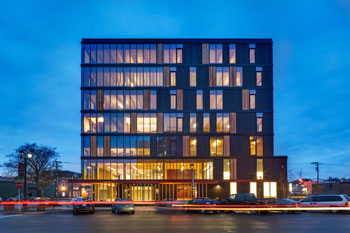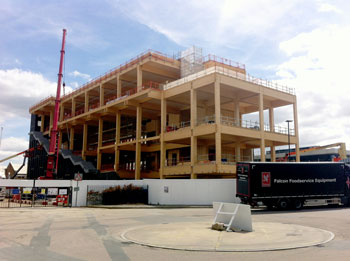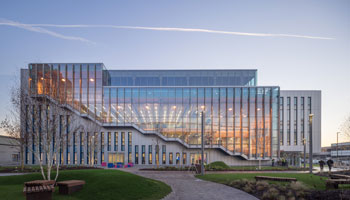Code changes and multi-storey timber – a brief international overview
Many building codes around the world try not to discriminate based on materials, preferring a judgment based on function alone. Throughout the EU the materials are unimportant as long as the design fulfils the six essential requirements of stability, fire safety, safety in usage, noise protection, energy economy and health/environmental concerns.
However, traditionally multi-story projects in the EU and UK have not used wood due to concerns about its ability to meet acoustic and fire safety ratings. In countries without extensive traditions in wood construction such as the UK, where concrete and steel have become the norm, a lack of labour skilled in working with mass timber has also restricted growth in the use of wood in these buildings.

Wood Design and Innovation Centre, MGA - details below
More recently the UK has seen an increase in multi-storey timber buildings, especially for residential and education applications, largely due to carbon footprint requirements, imposed by various levels of government.
In Canada, a multitude of code changes was instigated in 2009 by the province of British Colombia. They raised the maximum height for wood-framed residential buildings from four to six stories and enacted the Wood First Act, where government-funded building projects were required to be constructed from wood wherever possible.
This change to the code and the culture began a vast increase in the number of wood-constructed projects, with over 250 either completed or begun in the intervening period. The success of these efforts has seen other Canadian provinces enact similar reforms to their building codes.

Sky Believe in Better Building, Arup - details below

Sky Believe in Better Building, Arup - details below
By 2010, two Scandinavian countries also changed their building codes to allow taller residential structures built with wood framing or out of mass timber products such as cross-laminated timber (CLT). The code in Sweden allows for apartments of up to eight stories to be built from wood, many of which achieve passive house energy classification.
Finland soon followed suit in changing their codes to more closely align with their neighbour, allowing for wood-frame structures of up to the same eight story mark as long as suitable fire-resistance measures were put in place.
This, again combined with government encouragement towards building more wood buildings and a healthy familiarity with wood construction in these countries, has seen a large increase in the number of buildings with wood as the structural material.
The USA has a long history of wood construction in single-family dwellings, but their building codes have always been very fragmented and under the overview of individual cities. There is a current trend towards adopting model codes such as the International Building Code (IBC). However, cities adopt versions of this code from different years, exclude parts of the code that are unsuitable or unwelcome and adjust sections to suit their preferences. While sensible to modify the code for their specific requirements, it does result in a confusing system that cannot accept large changes over the multitude of codes.
These examples from different countries around the world show that, for a significant shift from concrete/steel structures to ones of mass timber or timber-framed construction, changes to the building codes often do not come alone. Instead, they are frequently accompanied by a corresponding encouragement from the governing body towards builders and designers to use wood in their buildings. This was seen in Canada in 2009 with the Wood First Act and in Finland the following year.
More advanced wood building systems are continually being developed and refined, and so around the world we see building codes shifting to avoid discrimination based on material and instead judged solely on performance.
Today, Australia joins the many countries around the world allowing their citizens, economies and environments to benefit from the advantages of multi-storey timber construction.
|
Project Title |
Wood Innovation and Design Centre |
|
Architect/Designer |
Michael Green Architecture |
|
Building Location |
Canada |
|
Contact Information |
Michael Green Architecture - http://mg-architecture.ca/ |
|
Project Title |
Sky Believe in Better Building |
|
Architect/Designer |
Architect, Structural and MEP Engineers - Arup Associates |
|
Project Information |
The UK's first 4 storey all timber office building was completed in just 42 weeks, thanks to the choice of timber for the frame, slabs and facade. The lightweight nature of wood combined with the ability to cnc machine to high tolerances makes it ideal for prefabrication. Arup made detailed acoustic studies and concluded that the frame could be left fully exposed, and that combined with only a standard raised floor and carpets would provide sufficient acoustic isolation between floors. 2015 was a successful year for Believe in Better Building (BiBB) and timber buildings in Arup. · BiBB won the WAN Wood Awards 2014 · Institution of Civil Engineers, London – Building of the Year, 2015 · Structural Timber Awards – Best commercial project, best education project, best low-energy building, architect of the year and winner of winners · UK Wood Awards 2015 – Judges’ Special Award · Institution of Structural Engineers Awards (global) – Commendation for best commercial building. BiBB has been subject of case studies in Canada, UK, Asia and been visited by engineers, architects and developers from around the world. It is a great showcase for the potential of wood offices. |
|
Building Location |
London |
|
Photography accreditation |
Simon Kennedy and Arup Associates |
|
Contact Information |
Tim Snelson, Arup, Tim.Snelson@arup.com Nick Milestone, B&K Structures N.Milestone@bkstructures.co.uk |
